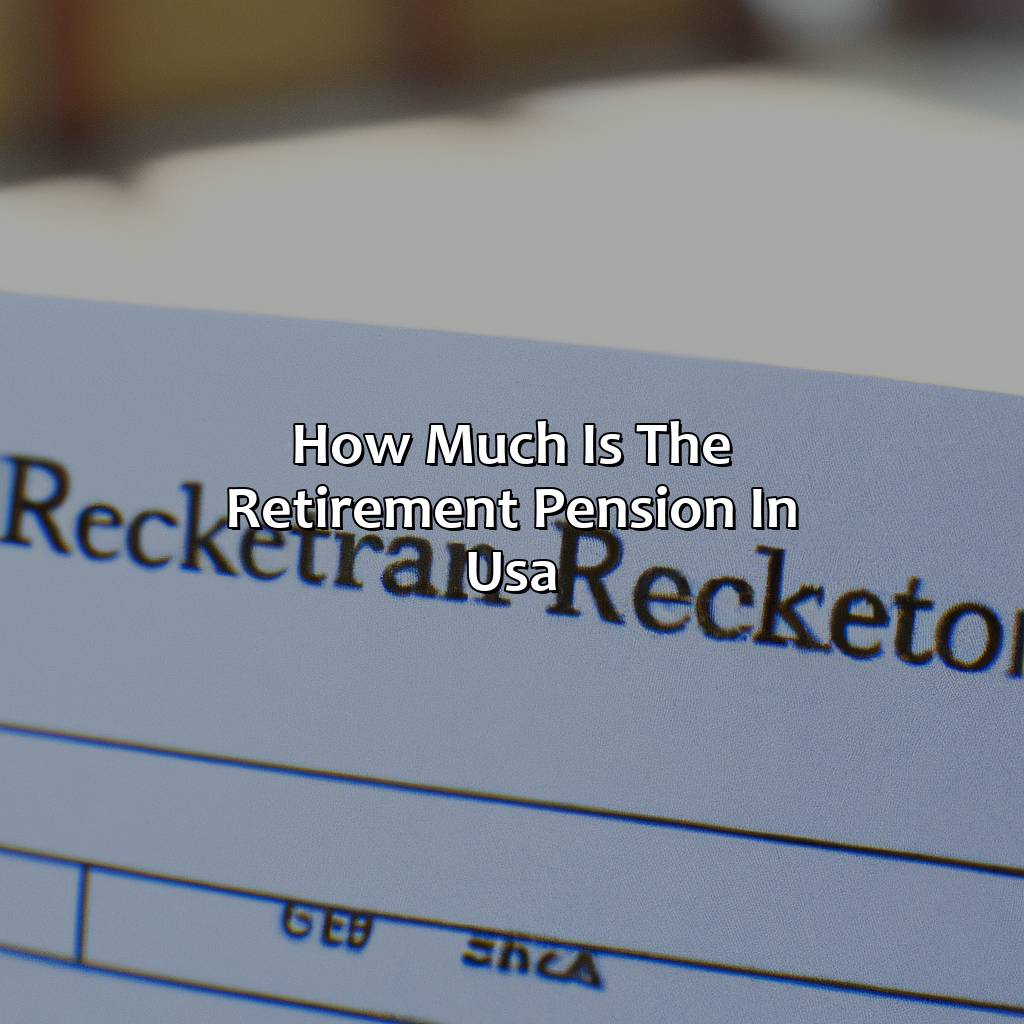How Much Is The Retirement Pension In Usa?
Key Takeaway:
- Retirement pension in the USA is calculated based on the average of the highest 35 years of earnings, with a maximum benefit of $3,148/month for those who retire at full retirement age.
- Eligibility criteria for retirement pension includes earning a minimum of 40 credits, with one credit earned for every $1,470 of earnings, up to a maximum of 4 credits per year.
- Supplemental retirement benefits, such as Social Security benefits, individual retirement accounts, and employer-sponsored retirement plans, can help individuals achieve a more comfortable retirement.
Are you curious about the financial future of your retirement? The US retirement pension system is complicated, but you can get clarity on this topic with this guide. Discover the current retirement pension available in the US and how to get the most from it.
Retirement Pension in the USA
Know the rules to get retirement pension in the USA. Eligibility criteria, calculation process and factors that affect the amount. The Retirement Pension in the USA section will help. It will guide you to know what you need.

Image credits: retiregenz.com by David Arnold
Eligibility Criteria for Retirement Pension
To be eligible for retirement pension in the USA, there are certain criteria that one needs to meet. These requirements include age limit, work credits, and citizenship status. To receive full retirement benefits, an individual must have attained the age of 66 years or older, depending on their birth year. Additionally, the applicant must have earned a minimum of 40 work credits to qualify for Social Security retirement benefits.
Furthermore, non-citizens who reside in the USA may also be eligible for social security retirement benefits if they satisfy specific requirements. This includes permanent residency or meeting other lawful presence criteria established by the Social Security Administration.
If you are curious about how much for disability pension, you can check out our article for more information.
It is crucial to note that eligibility criteria keep changing over time and can vary by state and occupation. Therefore, it’s best to consult with a professional financial advisor to know your exact requirements based on your unique circumstances.
Don’t miss out on getting the maximum retirement benefit you deserve! Ensure you understand each requirement as per your situation. Seek advice from professionals or reach out to Social Security offices nearest to you for more information on what grants someone eligibility for widows pension.
Looks like it’s time to dust off that calculator and start crunching some retirement numbers, because Social Security won’t suffice for those daily avocado toast cravings.
Calculation of Retirement Pension
Retirement Pension Calculation:
A retiree’s pension, commonly referred to as retirement income, is calculated based on their average earnings and years of service. This determines the amount payable to the retiree from employer contributions. To compare and find out how much is pension in UK, visit RetireGenZ.
Calculation of Retirement Pension:
| Age at retirement | Years of Service | Average Final Earnings | Estimated Monthly Benefit |
|---|---|---|---|
| 65 | 20 | $70,000 | $1,750 |
| 65 | 25 | $70,000 | $2,188 |
| 65 | 30 | $70,000 | $2,625 |
Source: Social Security Administration
For a retiree who has worked for a certain number of years and has an average final salary of $70,000 at the age of 65, their estimated monthly benefit varies according to how many years of service they have accumulated. The columns in the table above exhibit a precise computation based on those particulars.
Interested in finding out the average pension for a nurse? Check out our website for more information.
To qualify for a full Social Security retirement benefit if born in 1960 or later are required to have accumulated 35 years of work credits. Generally speaking, recipients get around 40 percent less than what they might expect if registered early – registering early reduces the associated benefits over the long run.
Preparing for retirement is like playing a game of chess, except the only piece you have left is your pension.
Factors Affecting Retirement Pension Amount
Various factors impact the retiree’s pension sum, including the salary earned during the working years, duration of employment, and age at which an individual begins to collect their benefits. Other aspects could influence the amount as well, such as employment history, inflation rate, and fluctuation in economic conditions. These elements determine a pensioner’s financial stability during their post-retirement days.
Moreover, law amendments and contribution changes made by Social Security Administration might also have an impact on how much retirement benefits one can receive. Alongside these factors, benefits from other pensions or investments may affect the overall retirement income positively or negatively. It is crucial to understand each element affecting your pensionable amount to plan effectively for your average pension.
As for the retirement pensions in America, The College Investor states that Social Security makes up 33% of American senior citizens’ entire income source.
If you’re wondering about how much is the aged pension, you can check out this helpful resource.
Planning for retirement is like playing a game of Jenga, hoping your supplemental benefits don’t leave you with a toppling tower of financial stress.
Supplemental Retirement Benefits
If you’re in the USA and want to beef up your retirement income, take a look at the “Supplemental Retirement Benefits” section. This covers Social Security Benefits, Individual Retirement Accounts, and Employer-Sponsored Retirement Plans. Let’s take a closer look at each of these options. See how they can help you boost your retirement savings!

Image credits: retiregenz.com by Joel Washington
Social Security Benefits
The retirement benefit program of the United States, known as Social Security Benefits, provides income for retired individuals, their surviving dependents and disabled people. These benefits are calculated based on an individual’s earnings history and age at the time of retirement.
For those who retire at full retirement age, which is typically between 66 to 67 years old depending on the year of birth, the monthly benefit amount can range from $800 to $3,000 or more. The amount received may increase if the individual waits until age 70 to retire. If you’re wondering how much is the old age pension, this article provides more information.
It is worth noting that these benefits may not be enough for a comfortable retirement lifestyle and supplemental savings are recommended. Consult with a financial advisor to maximize your benefits and avoid missing out on important opportunities for your future. Wondering how much is the retirement pension in the Philippines? Check it out here.
The only thing more certain than death and taxes is the need for an IRA.
Individual Retirement Accounts
Retirement Accounts for Individuals are a type of savings account designed to help people save and invest money for their retirement years. These accounts offer various tax benefits that incentivize individuals to save more. They come in different types, including:
- Traditional IRA
- Roth IRA
- Simplified Employee Pension (SEP) IRA
- Simple IRA
Each has specific eligibility requirements and contribution limits based on factors such as age and income level.
It’s important to note that the funds saved in these accounts are intended for use during retirement and cannot be withdrawn before a certain age without penalty. However, this penalty may be waived for qualifying circumstances such as disability or first-time home purchases. If you are wondering how long a pension lasts, it will depend on various factors such as retirement age, life expectancy, and contribution amount.
What sets Retirement Accounts for Individuals apart from other investment options is their tax advantages. Contributions made to these accounts are typically tax-deferred or tax-free until withdrawal during retirement. This means that the account holder can benefit from potential compound interest growth over time without having to pay taxes on it immediately.
While there are limitations to how much an individual can contribute each year, Retirement Accounts provide an excellent opportunity for anyone looking to plan ahead for their future financial security. If you’re wondering how much you should pay into your pension, it’s important to talk to a financial advisor who can help you determine the best course of action based on your individual circumstances.
A recent study showed that nearly half of Americans have no retirement savings at all. However, by taking advantage of opportunities like Individual Retirement Accounts, individuals can take control of their financial future and ensure they have enough saved up when they retire.
If you’re lucky enough to have an employer-sponsored retirement plan, just remember: your retirement dreams might depend on your boss not being a total jerk.
Employer-Sponsored Retirement Plans
Employers offer retirement benefits packages to help employees save for retirement. These benefits, also known as ‘Corporate Retirement Plans’, can include pension plans, 401(k)s, and other savings options.
- Corporate Retirement Plans provide a steady flow of income throughout retirement.
- Employer contributions increase the amount of money saved for retirement.
- Some employers offer matching contributions to boost employee savings.
- Certain Corporate Retirement Plans are subject to government regulations.
In addition to employers offering Corporate Retirement Plans, some companies also offer Supplemental Retirement Benefits which provide extra financial support during retirement.
Fidelity Investments reported in 2020 that the average 401(k) balance for US workers is around $100,000.
Some Facts About Retirement Pension in USA:
- ✅ The maximum retirement benefit in 2021 for someone who retires at full retirement age is $3,148 per month. (Source: Social Security Administration)
- ✅ The average retirement benefit in 2021 for a retired worker is $1,543 per month. (Source: Social Security Administration)
- ✅ The earliest age to start receiving retirement benefits is 62, but the monthly benefit is reduced by up to 30% for starting at this age. (Source: AARP)
- ✅ The full retirement age for people born in 1960 and later is 67. (Source: Social Security Administration)
- ✅ Social Security retirement benefits are adjusted annually to keep up with inflation and changes in the cost of living. (Source: Social Security Administration)
FAQs about How Much Is The Retirement Pension In Usa?
How much is the retirement pension in USA?
The amount of the retirement pension in the USA varies depending on different factors like age, income, and years of work. However, the average monthly retirement pension for a worker who retires at full retirement age is currently $1,413.
What is the maximum social security retirement benefit?
The maximum social security retirement benefit varies depending on the year in which you turn 62 or your retirement age, whichever is greater. As of 2021, the maximum monthly benefit for a worker who retires at full retirement age is $3,148. However, most beneficiaries receive less than the maximum amount.
Can you receive a retirement pension and social security at the same time?
Yes, you can receive a retirement pension and social security at the same time. However, if you receive a pension from a job where you did not pay social security taxes, your social security benefit may be reduced.
How do I calculate my retirement pension?
You can use the Social Security Administration’s online Retirement Estimator tool to calculate your retirement pension. You will need to provide your date of birth, earnings history, and estimated retirement age.
Can I retire and start receiving my pension at age 62?
Yes, you can retire and start receiving your pension as early as age 62. However, if you start receiving your pension before your full retirement age, your benefit will be reduced.
What is the full retirement age for social security benefits?
The full retirement age for social security benefits depends on the year in which you were born. For individuals born in 1960 or later, the full retirement age is 67. For those born between 1943 and 1954, the full retirement age is 66.


